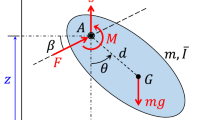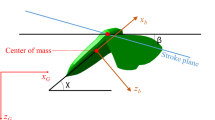Abstract
This paper discusses the effects of wing inertial forces on flight stability and required lift for hovering of insects with a varying stroke plane. In this paper, the stroke plane of a flying insect is called varying if the angle between the stroke plane and insect’s body remains constant during flight. Using a quasi-steady aerodynamic model and averaging techniques, while including the wing inertial forces in flight dynamics, the analytical results show that for an insect with a varying stroke plane the wing inertial forces have destabilizing effects on the insect’s translational motion during hover. Besides, the results suggest that an insect with a varying stroke plane requires less aerodynamic lift than its weight and a nonzero-mean drag for a stable hovering flight. Numerical simulations support the analytical results. To realize the mechanics behind the destabilizing effects of the wing inertial forces of an insect with a varying stroke plane and explain the properties of the lift and drag required for a stable hover, first, the vibrational control of a three degree of freedom force-input pendulum with a varying force direction is discussed.





Similar content being viewed by others
Data availability
All data generated or analyzed during this study are included in this published article.
References
Ellington, C.P.: The aerodynamics of the hovering insect flight. III. Kinematics. Philos. Trans. R. Soc. B Biol. Sci. 305(1122), 41–78 (1984)
Deng, X., Schenato, L., Sastry, S.S.: Flapping flight for biomimetic robotic insects, part 2: flight control design. IEEE Trans. Robot. 22(4), 789–803 (2006)
Doman, D.B., Oppenheimer, M.W., Sigthorsson, D.O.: Wingbeat shape modulation for flapping-wing micro-air-vehicle control during hover. J. Guid. Control. Dyn. 33(3), 724–739 (2010)
Tahmasian, S., Woolsey, C.A.: Flight control of biomimetic air vehicles using vibrational control and averaging. J. Nonlinear Sci. 27(4), 1193–1214 (2017)
Wood, R.J.: The first takeoff of a biologically inspired at-scale robotic insect. IEEE Trans. Robot. 24(2), 341–347 (2008)
Gerdes, J.W., Gupta, S.K., Wilkerson, S.A.: A review of bird-inspired flapping wing miniature air vehicle designs. J. Mech. Robot. 4(2), 021003 (2012)
Zhang, C., Rossi, C.: A review of compliant transmission mechanisms for bio-inspired flapping-wing micro air vehicles. Bioinspir. Biomim. 12, 025005 (2017)
Xiao, S., Hu, K., Huang, B., Deng, H., Ding, X.: A review on the mechanical design of hoverable flapping wing micro-air vehicles. J. Bionic Eng. 18, 1235–1254 (2021)
Phan, H.V., Park, H.C.: Generation of control moments in an insect-like tailless flapping-wing micro air vehicle by changing the stroke-plane angle. J. Bionic Eng. 13, 449–457 (2016)
Nguyen, Q., Chan, W.L.: Development and flight performance of a biologically-inspired tailless flapping-wing micro air vehicle with wing stroke plane modulation. Bioinspir. Biomim. 14, 016015 (2019)
Taylor, G.K., Thomas, A.L.R.: Animal flight dynamics II. Longitudinal stability in flapping flight. J. Theor. Biol. 214(3), 351–370 (2002)
Faruque, I., Sean Humbert, J.: Dipteran insect flight dynamics. Part 1: longitudinal motion about hover. J. Theor. Biol. 264(2), 538–552 (2010)
Cheng, B., Deng, X.: Translational and rotational damping of flapping flight and its dynamics and stability at hovering. IEEE Trans. Robot. 27(5), 849–864 (2011)
Cheng, B., Deng, X., Hedrick, T.L.: The mechanics and control of pitching maneuvers in a freely flying hawkmoth (Manduca sexta). J. Exp. Biol. 214, 4092–4106 (2011)
Karasek, M., Preumont, A.: Flapping flight stability in hover: a comparison of various aerodynamic models. Int. J. Micro Air Veh. 4(3), 203–226 (2012)
Ristroph, L., Ristroph, G., Morozova, S., Bergou, A.J., Chang, S., Guckenheimer, J., Jane Wang, Z., Cohen, I.: Active and passive stabilization of body pitch in insect flight. J. R. Soc. Interface 10, 20130237 (2013)
Elzinga, M.J., van Breugel, F., Dickinson, M.H.: Strategies for the stabilization of longitudinal forward flapping flight revealed using a dynamically-scaled robotic fly. Bioinspir. Biomim. 9(2), 025001 (2014)
Taha, H.E., Hajj, M.R., Nayfeh, A.H.: Longitudinal flight dynamics of hovering MAVs/insects. J. Guid. Control. Dyn. 37(3), 970–978 (2014)
Taha, H.E., Nayfeh, A.H., Hajj, M.R.: Effects of the aerodynamic-induced parametric excitation on the longitudinal stability of hovering MAVs/insects. Nonlinear Dyn. 78, 2399–2408 (2014)
Taha, H.E., Tahmasian, S., Woolsey, C.A., Nayfeh, A.H., Hajj, M.R.: The need for higher-order averaging in the stability analysis of hovering, flapping-wing flight. Bioinspir. Biomim. 10, 016002 (2014)
Yao, J., Yeo, K.S.: A simplified dynamic model for controlled insect hovering flight and control stability analysis. Bioinspir. Biomim. 14, 056005 (2019)
Taha, H.E., Kiani, M., Hedrick, T.L., Greeter, J.S.M.: Vibrational control: a hidden stabilization mechanism in insect flight. Sci. Robot. 5, eabb1502 (2020)
Wu, J.H., Zhang, Y.L., Sun, M.: Hovering of model insects: simulation by coupling equations of motion with Navier–Stokes equations. J. Exp. Biol. 212(20), 3313–3329 (2009)
Orlowski, C.T., Girard, A.R.: Longitudinal flight dynamics of flapping-wing micro air vehicles. J. Guid. Control. Dyn. 35(4), 1115–1131 (2012)
Wu, J.H., Sun, M.: Floquet stability analysis of the longitudinal dynamics of two hovering model insects. J. R. Soc. Interface 9, 2033–2046 (2012)
Sun, M.: Insect flight dynamics: stability and control. Rev. Mod. Phys. 86, 615–646 (2014)
Kim, J.-K., Han, J.-S., Lee, J.-S., Han, J.-H.: Hovering and forward flight of the hawkmoth Manduca sexta: trim search and 6-DOF dynamic stability characterization. Bioinspir. Biomim. 10, 056012 (2015)
Taha, H.E., Woolsey, C.A., Hajj, M.R.: Geometric control approach to longitudinal stability of flapping flight. J. Guid. Control. Dyn. 39(2), 214–226 (2016)
Bluman, J., Kang, C.-K.: Wing-wake interaction destabilizes hover equilibrium of a flapping insect-scale wing. Bioinspir. Biomim. 12, 046004 (2017)
Xu, R., Zhang, X., Liu, H.: Effects of wing-to-body mass ratio on insect flapping flight. Phys. Fluids 33(3), 021902 (2021)
Lyu, Y.Z., Sun, M.: Power requirements for the hovering flight of insects with different sizes. J. Insect Physiol. 134, 104293 (2021)
Tahmasian, S., Kotulak-Smith, B.C.: The effects of wing inertial forces and mean stroke angle on the pitch stability of hovering insects. arXiv:2306.15592 (2023)
Orlowski,Christopher T.: Flapping wing micro air vehicles: an analysis of the importance of the mass of the wings to flight dynamics, stability, and control. Ph.D. thesis, University of Michigan, Ann Arbor (2011)
Orlowski, C.T., Girard, A.R.: Dynamics, stability, and control analyses of flapping wing micro-air vehicles. Prog. Aerosp. Sci. 51, 18–30 (2012)
Ellington, C.P.: The aerodynamics of the hovering insect flight. VI. Lift and power requirements. Philos. Trans. R. Soc. B Biol. Sci. 305(1984), 145–181 (1122)
Farrell Helbling, E., Wood, R.J.: A review of propulsion, power, and control architectures for insect-scale flapping-wing vehicles. Appl. Mech. Rev. 70(1), 010801 (2018)
Bogoliubov, N.N., Mitropolsky, Y.A.: Asymtotic Methods in the Theory of Non-linear Oscillations. Hindustan Publishing Corporation, Delhi (1961)
Sanders, J.A., Verhulst, F.: Averaging Methods in Nonlinear Dynamical Systems. Applied Mathematical Sciences. Springer, New York (1985)
Guckenheimer, J., Holmes, P.: Nonlinear Oscillations, Dynamical Systems, and Bifurcations of Vector Fields. Applied Mathematical Sciences. Springer, New York (1983)
Bullo, F.: Averaging and vibrational control of mechanical systems. SIAM J. Control. Optim. 41(2), 542–562 (2002)
Bullo, F., Lewis, A.D.: Geometric Control of Mechanical Systems. Texts in Applied Mathematics. Springer, New York (2005)
Tahmasian, S., Woolsey, C.A.: On closed-loop vibrational control of underactuated mechanical systems. Nonlinear Dyn. 108, 329–347 (2022)
Meerkov, S.M.: Vibrational control theory. J. Frankl. Inst. 303(2), 117–128 (1977)
Meerkov, S.M.: Principle of vibrational control: theory and applications. IEEE Trans. Autom. Control 25(4), 755–762 (1980)
Meirovitch, L.: Methods of Analytical Dynamics. Dover Publications, New York (2003)
Vela, P.A., Burdick, J.W.: A general averaging theory via series expansions. In: Proceedings of the American Control Conference, Denver, CO, June, pp. 1530–1535 (2003)
Vela, P.A., Morgansen, K.A., Burdick, J.W.: Second order averaging methods for oscillatory control of underactuated mechanical systems. In: Proceedings of the American Control Conference, Anchorage, AK, May, pp. 4672–4677 (2002)
Sarychev, A.: Stability criteria for time-periodic systems via high-order averaging techniques. In: Thoma, M., Allgower, F., Morari, M. (eds.) Nonlinear Control in the Year 2000, pp. 365–377. Springer, Berlin (2001)
Mou, X.L., Liu, Y.P., Sun, M.: Wing motion measurement and aerodynamics of hovering true hoverflies. J. Exp. Biol. 214(17), 2832–2844 (2011)
Liu, Y., Sun, M.: Wing kinematics measurement and aerodynamics of hovering droneflies. J. Exp. Biol. 211(13), 2014–2025 (2008)
Dudley, R., Ellington, C.P.: Mechanics of forward flight in bumblebees I. Kinematics and morphology. J. Exp. Biol. 148(1), 19–52 (1990)
Funding
The author did not receive support from any organization for the submitted work.
Author information
Authors and Affiliations
Corresponding author
Ethics declarations
Conflict of interest
The author declares that he has no conflict of interest.
Additional information
Publisher's Note
Springer Nature remains neutral with regard to jurisdictional claims in published maps and institutional affiliations.
Rights and permissions
Springer Nature or its licensor (e.g. a society or other partner) holds exclusive rights to this article under a publishing agreement with the author(s) or other rightsholder(s); author self-archiving of the accepted manuscript version of this article is solely governed by the terms of such publishing agreement and applicable law.
About this article
Cite this article
Tahmasian, S. The effects of wing inertial forces on flight stability of hovering insects with varying stroke plane. Nonlinear Dyn 112, 317–330 (2024). https://doi.org/10.1007/s11071-023-09053-x
Received:
Accepted:
Published:
Issue Date:
DOI: https://doi.org/10.1007/s11071-023-09053-x




